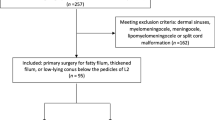Abstract
Background
Tethered spinal cord syndrome (TCS) is characterized by attachment of the spinal cord down toward the tail end of the spine, comprising the danger of myelopathic symptoms. We retrospectively analyzed postoperative neurological outcome in adult patients with congenital TCS with special regard to the extent of resection of concomitant intraspinal lipomas.
Methods
Medical records of 27 adult patients with congenital TCS (both with and without associated spinal lipomas) undergoing microsurgical detethering were systematically analyzed. Neurophysiological monitoring was available and feasible for all cases. Outcome parameters were preoperatively and postoperative neurological status; Wilcoxon rank test was used for statistical analysis.
Results
In all patients, complete detethering was achieved. While urinary symptoms remained stable, all patients showed a non-significant tendency towards improvement of sensorimotor deficits. Both, patients with and without spinal lipoma experienced a significant postoperative amelioration of back pain. Patients with lipoma were found to suffer significantly less from radicular pain postoperatively (3/16). Furthermore, patients with a history of pain shorter than 1 year showed a significantly better chance for postoperative relief from back and radicular pain. The extent of lipoma resection had no significant impact on postoperative outcome.
Conclusions
Adult patients with symptomatic TCS profit from detethering, especially regarding relief of lower back and radicular pain. Complete removal of associated spinal lipomas does not seem to be mandatory for achieving a satisfying result.



Similar content being viewed by others
References
Aufschnaiter K, Fellner F, Wurm G (2008) Surgery in adult onset tethered cord syndrome (ATCS): review of literature on occasion of an exceptional case. Neurosurg Rev 31:371–383
Bowman RM, Mohan A, Ito J, Seibly JM, McLone (2009) Tethered cord release: a long term study in 114 patients. J Neurosurg Pediatr 3:181–187
Bulsara KR, Zomorodi AR, Villavicencio AT, Fuchs H, George TM (2001) Clinical outcome differences for lipomyelomeningoceles, intraspinal lipomas, and lipomas of the filum terminale. Neurosurg Rev 24:192–194
Düz B, Gocmen S, Secer HI, Basal S, Gönül E (2008) Tethered cord syndrome in adulthood. J Spinal Cord Med 31:272–278
Filippidis AS, Kalani MY, Theodore N, Rekate HL (2010) Spinal cord traction, vascular compromise, hypoxia, and metabolic derangements in the pathophysiology of tethered cord syndrome. Neurosurg Focus 29:E9
Garcés-Ambrossi GL, McGirt MJ, Samuels R, Sciubba DM, Bydon A, Gokaslan ZL, Gokaslan ZL, Jallo GI (2009) Neurological outcome after surgical management of adult tethered cord syndrome. J Neurosurg Spine 11:304–309
Gupta SK, Khosla VK, Sharma BS, Mathuriya SN, Pathak A, Tewari MK (1999) Tethered cord syndrome in adults. Surg Neurol 52:362–369
Herman JM, McLone DG, Storrs BB, Dauser RC (1993) Analysis of 153 patients with myelomeningocele or spinal lipoma reoperated upon for a tethered cord. Presentation, management and outcome. Pediatr Neurosurg 19:243–249
Hüttmann S, Krauss J, Collmann H, Sörensen N, Roosen K (2001) Surgical management of tethered spinal cord in adults: report of 54 cases. J Neurosurg 95:173–178
Iskandar BJ, Fulmer BB, Hadley MN, Oakes WJ (2001) Congenital tethered spinal cord syndrome in adults. Neurosurg Focus 10:e7
Klekamp J (2011) Tethered cord syndrome in adults. J Neurosurg Spine 15(3):258–270
Krassioukov AV, Sarjeant R, Arkia H, Fehlings MG (2004) Multimodality intraoperative monitoring during complex lumbosacral procedures: indications, techniques, and long-term follow-up review of 61 consecutive cases. J Neurosurg Spine 1:243–253
Lee GY, Paradiso G, Tator CH, Gentili F, Massicotte EM, Fehlings MG (2006) Surgical management of tethered cord syndrome in adults: indications, techniques, and long-term outcomes in 60 patients. J Neurosurg Spine 4:123–131
McLone DG (1996) The adult with a tethered cord. Clin Neurosurg 43:203–209
Milhorat TH, Bolognese PA, Nishikawa M, Francomano CA, McDonnell NB, Roonprapunt C, Kula RW (2009) Association of Chiari malformation type I and tethered cord syndrome: preliminary results of sectioning filum terminale. Surg Neurol 72:20–35
Potts MB, Wu JC, Gupta N, Mummaneni PV (2010) Minimally invasive tethered cord release in adults: a comparison of open and mini-open approaches. Neurosurg Focus 29:E7
Quiñones-Hinojosa A, Gadkary CA, Gulati M, von Koch CS, Lyon R, Weinstein PR, Yingling CD (2004) Neurophysiological monitoring for safe surgical tethered cord syndrome release in adults. Surg Neurol 62:127–133
Rajpal S, Tubbs RS, George T, Oakes WJ, Fuchs HE, Hadley MN, Iskandar BJ (2007) Tethered cord due to spina bifida occulta presenting in adulthood: a tricenter review of 61 patients. J Neurosurg Spine 6:210–215
Selçuki M, Vatansever S, Inan S, Erdemli E, Bağdatoğlu C, Polat A (2003) Is a filum terminale with a normal appearance really normal? Childs Nerv Syst 19:3–10
Stavrinou P, Kunz M, Lehner M, Heger A, Müller-Felber W, Tonn JC, Peraud A (2010) Children with tethered cord syndrome of different etiology benefit from microsurgery-a single institution experience. Childs Nerv Syst 27:803–810
Stetler WR, Park P, Sullivan S (2010) Pathophysiology of adult tethered cord syndrome: review of the literature. Neurosurg Focus 29:E2
Yamada S, Knerium DS, Mandybur GM, Schultz RL, Yamada BS (2004) Pathophysiology of tethered cord syndrome and other complex factors. Neurol Res 26:722–726
Disclaimer
The authors report no conflict of interest concerning the materials or methods used in this study or the findings specified in this paper.
Conflicts of interest
None.
Author information
Authors and Affiliations
Corresponding author
Rights and permissions
About this article
Cite this article
Romagna, A., Suchorska, B., Schwartz, C. et al. Detethering of a congenital tethered cord in adult patients: an outcome analysis. Acta Neurochir 155, 793–800 (2013). https://doi.org/10.1007/s00701-013-1652-x
Received:
Accepted:
Published:
Issue Date:
DOI: https://doi.org/10.1007/s00701-013-1652-x




